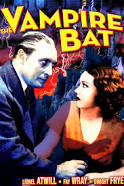
“While you’re hunting for vampires and chasing bats I’m looking for a human being.”
Kleinshloss is a small village in Eastern Europe. A serial killer is at work in the countryside. He drains the blood from his victims. The locals are frightened and demand something be done. The Burgomaster Gustave Schoen (Lionel Belmore) is convinced they have a vampire in their midst and that it is responsible for the deaths. The police inspector Karl Brettschneider (Melvyn Douglas), on the other hand is not ready to accept the existence of vampires. He finds it all very superstitious. The Burgomaster’s description of the recent deaths is quite colorful. The police chief is not impressed.
The local doctor, Otto Von Newman (Lionel Atwell) has been treating the villagers. He is aware of a disease that can make a person believe they are a vampire. His most recent patient is Martha Mueller the apple vendor. She says she was attacked by a giant bat. When she dies the prime suspect becomes the simple minded Herman Gleib (Dwight Frye). He is childlike and makes friends with the bats and likes to play with them.
When another villager dies a group of vigilantes, replete with torches and clubs, chases Herman through the countryside. They corner him on a ledge and he falls to his death. Wanting to make sure he is dead, the villagers drive a stake through his heart.
In the meantime the killings do not stop. Dr. Von Newman's housekeeper Georgiana (Stella Adams) is attacked by the killer. When Karl finds out that Herman was already dead when Georgiana was attacked he knows that the killer is a real flesh and blood mad man. And he is still on the loose.
“The Vampire Bat” was released in 1933 and was directed by Frank R. Strayer. The sets used for the village are the same ones used for “Frankenstein” (1931). The interiors were those used for “The Old Dark House” (1932). It’s an entertaining piece of film that doesn’t require anything more than to just enjoy it. We can forgive the movie makers for borrowing elements from the most popular movies of the era since what we get in return is actually a great slice of history. Between the veteran actors, the subject matter and poverty row type of movie making we have, although not a box office hit, a really interesting combination of old fashioned movie on a bargain basement budget.
Dwight Frye, who plays the simple-minded Herman Gleib, does the best insane characters ever. Some of his credits are Renfield in “Dracula” (1931) and the sadistic Fritz in “Frankenstein” (1931). Unfortunately he played these types of characters so well he was type cast for a lot of his career playing half-wits, villains and mentally disturbed patients. The movie also stars Fay Wray as Ruth Bertin the police inspector Karl’s love interest, but by far the best performance is by Maude Eburne. She plays Ruth’s aunt Gussie Schnappmann. Like Dwight Frye eccentric roles are her specialty. The movie is worth it just to see Dwight and Maude in action.

